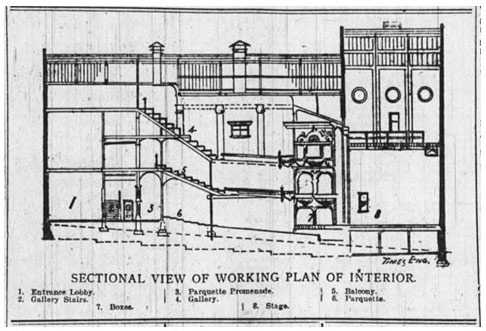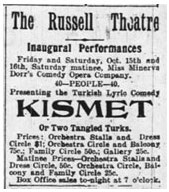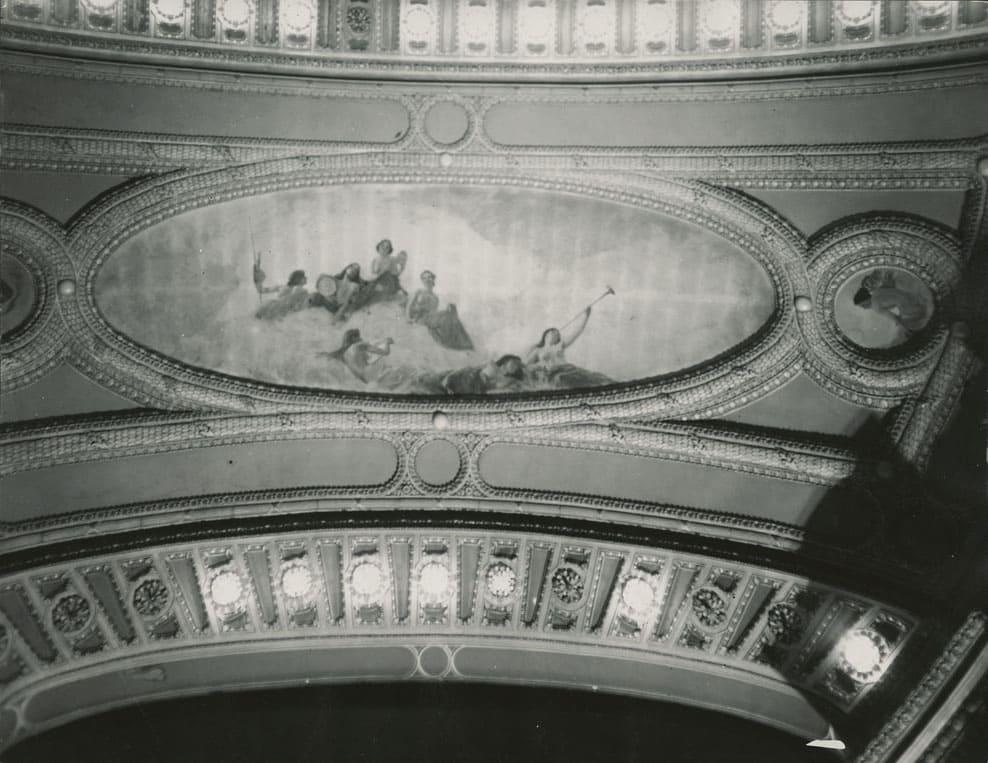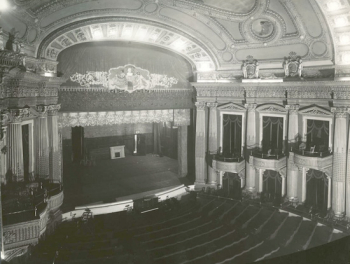15 October 1897
On the site of the National Arts Centre (NAC) there once stood an earlier playhouse called The Russell Theatre with its front entrance on Queen Street. On hundred years ago, it was the centre of arts and culture in Ottawa just as the NAC is today. The three-storey structure, which cost $100,000 to build, was owned by The Russell Company, the proprietor of the adjacent Russell House Hotel, which was itself the city’s leading hotel prior to the building of the Château Laurier. Work on the site began at the end of March 1897 when labourers tore down the old “Leader Hotel,” also known as the “Walsh building,” on Queen Street. The Russell Company, seeking the finest that money could buy, hired the New York theatrical architectural firm of J. B. McElfatrick and Son that had built theatres across the United States. Michigan native Fuller Claflin was the on-site architect. The general contractor for the project was Mr “Ed” C. Horne of New York, with whom Claflin had worked on many similar assignments. Imported talent, mostly from the United States, also made the stage decorations, the tile mosaics, the papier maché work, as well as the ornamental paintings and frescos. Even the masons and bricklayers employed on the job came principally from New York. Dr W. A. Drowne, who had been the manager of the Plattsburgh theatre in Plattsburgh, New York, was hired to manage the new Russell Theatre.
 Cross section of The Russell Theatre
Cross section of The Russell Theatre
The Evening Journal, 2 October 1897.The theatre, which was built in the Italian renaissance style, was a marvel of late nineteenth century technology, and was judged second to none among North American theatres. It seated roughly 1,500 patrons on three floors and in ten boxes. On the balcony, there was a large room where light refreshments were served during intermissions and after performances. A ladies’ parlour (a.k.a. bathroom) was to be found on the first floor, with the gentlemen’s toilets on the balcony level. In the gallery, there was a smoking lounge for gentlemen. The steam-heated building was equipped with the latest stage apparatus and a modern electrical lighting system, with the wires carefully run through brass tubing to deter fires. In the case of fire, it had a fire pump with ten water outlets each equipped with fire hoses distributed throughout the building. The ground floor was laid in concrete, and the stairwells were separated from the auditorium by brick walls. The proscenium opening was protected by an asbestos curtain. Asbestos was also used in the plaster to retard burning. In an act of hubris suitable for a Greek tragedy, The Evening Journal said the theatre was “practically fireproof.”
On 15 October 1897, the Russell Theatre officially opened its door to the general public. Seats for the premiere had been auctioned off a few days earlier, with the proceeds in excess of the established ticket prices donated to the Prescott and Russell Fire Relief Fund. Roughly $200 were raised to help victims of a massive bush fire that had earlier destroyed three villages in eastern Ontario—Casselman, South Indian and Cheney’s—killing at least six people and leaving hundreds homeless.
 Advertisement for Kismet, the Premiere Production at The Russell Theatre
Advertisement for Kismet, the Premiere Production at The Russell Theatre
The Evening Journal, 15 October, 1897The gala opening featured Kismet or Two Tangled Turks, a comic opera in two acts by the German-born Broadway composer Gustave Kirker, with the libretto by Richard F. Carroll. Unfortunately, the play “was not altogether a success” opined The Evening Journal. The performance lacked “snap and vim” and was judged “dull” for long periods. The problem seemed to lie more with the play than with the theatrical company. The newspaper said that Miss Minerva Dorr, who played the role of the Sultan (sic) of Turkey, had a commanding presence and an exquisite voice while Mr John Saunders was very humorous as the Grand Vizier. The dancers “of the Odalisques” were also judged to be quite pleasing. In general, the theatrical company was considered to have been good, but would have done better with a better play.
If the play was lacklustre, the theatre wowed Ottawa’s elite. Prior to the beginning of the performance, coloured lights played over the stage curtain that was painted with a scene of the loops of the Selkirk River of Manitoba. Being the première, people turned out in their finest with the newspaper giving a detailed account of the outfits of prominent Ottawa women. A Miss Davis wore “a dainty dress of dresden muslin-de-soie over cream silk, the trimming of cream lace and nile green satin ribbons forming a bolero and full front bodice. Diamond and pearl ornaments.”
It seems the Journal’s judgement of the Russell’s first theatrical production was an accurate assessment of the theatre’s first seasons—second-rate. In a letter to the editor, a theatre-goer in 1899 moaned that the Russell Theatre had claimed that it had been unable to book first-rate theatrical companies since they had already been contracted to play in Toronto and Montreal. He thought that while the excuse might have been a fiction, the result was “painful.” Another angry theatre patron complained that if Ottawa had to put up with second-rate attractions, at least the prices charged shouldn’t be higher than those charged in Montreal.
Fire put an end to the complaints. On 9 April 1901, roughly two hours after the last patrons had left a production of The Belle of New York, a musical comedy written by Hugh Morton with music again by Gustave Kirker, a fire broke out behind the Russell’s stage. Despite the asbestos curtain and other fire retarding measures, the theatre was quickly gutted, its wooden interior fixtures burning like tinder. The alarm was raised by the theatre’s caretaker who had an apartment close to the stage. He had just fallen asleep when he was woken by a loud rushing sound, with his room filling with smoke. Almost naked, he rushed out of the theatre to the nearby police station to bring help. Dr Drowne, the Russell’s manager, and Mrs Drowne who also lived in the theatre, barely escaped with their lives. They fled with only the clothes on their backs. All their possessions, valued at $2,000, were lost.
By the time Fire Chief Provost and his men got to the Russell Theatre, flames were already shooting through the roof. But firefighters were able to bring the blaze under control by plying water streams onto the structure from the Free Press Building at the corner of Queen and Elgin Streets. While the theatre was a write-off, the firemen were able to save surrounding buildings, including the Russell House Hotel. Aiding them was the weather—wet with the wind blowing away from the hotel.
The cause of the blaze was never ascertained. The caretaker thought it started in the furnace room. Others believed it had been caused by a wayward cigarette dropped by one of the players. However, Dr Drowne disagreed, saying he was very strict with smoking around the stage. Also, he had passed through the theatre after The Belle of New York troupe had left, and had checked on every room before retiring for the night.
The next day, Ottawa residents woke up to the realization that only by chance had a great tragedy been avoided. Had the fire broken out just two hours earlier, many men, women and children might have been trampled in a rush for the doors. Despite the considerable fire precautions taken in its construction, the consensus was that the theatre had not been safe due to insufficient exits, especially from the dress circle and balcony levels. Many considered the theatre to have been a “death trap.”
Speculation also began on whether the theatre would be rebuilt. The initial assessment was not favourable. Fire losses were estimated at $100,000, with insurance covering only $63,000. Also, the theatre had not been profitable; no dividends had been paid since the day it was opened. But at a meeting of directors four days after the fire, management announced that an arrangement had been reached to rebuild the Russell Theatre between the owners of the theatre and the Ambrose J. Small Company of Toronto, a theatre management company that had leased the Russell. Apparently, the Ambrose J. Small Company had already booked engagements for two-thirds of the coming season.
As an aside, many years later in 1919, Ambrose J. Small, who was a major Canadian theatre mogul who owned or operated theatres in several Ontario cities, was to disappear under circumstances worthy of a paperback thriller. After receiving $1.7 million from the sale of his theatre operations, it was alleged that he was murdered by his wife and her lover, with his body incinerated in the furnace of the Grand Opera Theatre in London, Ontario. The allegations were never proven. At one point, Sir Arthur Conan Doyle, the author of the Sherlock Holmes stories, was approached for assistance in solving the case. While interested, Sir Arthur declined to help. Never solved, the police closed the case in 1960.
 Ceiling of the new Russell Theatre showing “The Triumph of Drama” by Frederick Challener, RCA, 1928
Ceiling of the new Russell Theatre showing “The Triumph of Drama” by Frederick Challener, RCA, 1928
Library and Archives Caanda, Mikan 4821747The new Russell Theatre reopened on 7 October 1901, almost four years to the day after its first debut. Although rebuilt along similar lines to the original theatre and finished as before in old gold, ivory and red, with shades of blue under the galleries, there were significant differences. Capacity has increased to 1,900 seats from 1,500, with 590 on the ground floor, 500 in the balcony, 700 in the gallery, with the remainder accommodated in twelve boxes. There were other differences too. Most importantly, there were a lot more exits, including four on the gallery and three on the balcony. Frederick Challener, a distinguished Canadian artist, had also been commissioned to paint three murals on the ceiling, depicting the “Triumph of Drama,” “Love” and “Hate.”
The re-opening play was a production of Dolly Varden, a comic opera by the Broadway composer Julian Edwards based on the character Dolly Varden from the Charles Dickens’ book Barnaby Rudge. Miss Lulu Glaser played the lead role. This debut fared better than the first. The Journal’s review described the production as “bright and clever entertainment, while Miss Glaser was “vivacious and dainty.” Unlike Kismet in 1897, Dolly Varden had the necessary “vim.” The newspaper was particularly impressed by a chorus by the entire company performed a cappella. The costumes were also deemed to have been gorgeous.
During that first week, Dolly Varden played for two nights. This was followed by two nights of vaudeville by Shea’s Vaudeville from the Garden Theatre in Buffalo. The week was rounded out by a performance by Louis Morrison in The New Faust on the Friday, followed by Madame Modjeska and Louis James in productions of Mary Stuart and Henry VIII on the Saturday.
The curtain fell for the last time at the Russell Theatre on 14 April 1928. The theatre, along with the now empty Russell House Hotel and other properties on the Russell Block bordered by Sparks, Queen and Elgin Streets and the Canal had been acquired by the Federal District Commission (FDC). All were slated for demolition as part of the Commission’s plan to beautify Ottawa. On that last night, The Dumbells performed in “Bubbling Over,” a series of eleven comedic and musical acts, to a capacity crowd. Led by Captain Merton Plunkett, the troupe was a prominent and extremely popular Canadian vaudeville group that had been formed during World War I by members of Canada’s Third Division. The company took their name from the dumbbell emblem of the Third Division. At the end of their performance, Captain Plunkett told the audience that it was fitting that a strictly Canadian company should be the last to appear at the Russell.
As The Dumbells were loading their props and other equipment onto a horse-drawn cart after their show, the derelict Russell House Hotel caught fire. Although firemen were able to save the adjacent Russell Theatre from the flames, nothing could save it from the FDC. Three months later, it was demolished. Fortunately, on hearing of the existence of the beautiful ceiling murals by Frederick Challener, Canada’s National Gallery asked that they be saved. The murals now reside at the Gallery. In 1985, the Gallery also obtained Challener’s preliminary scale model of the main mural, Triumph of Drama. See Maquette of Triumph of Drama.
Sources:
Alberti, Louis-Gèrard, 2015. “The Russell Theatre,” The Canadian Encyclopedia.
Bordman, Gerald with Norton, Richard, 2010. American Musical Theatre, A Chronicle, 4th Edition, Oxford University Press: Oxford, New York.
Evening Journal (The), 1897. “Ottawa’s New Theatre,” 30 March.
—————————, 1897. “Down Comes The Wall,” 30 March.
—————————, 1897. “The Russell House Company,” 7 June.
————————–, 1897. “Opera House Decorations,” 14 July.
————————–, 1897. “At Work On The Scenery,” 18 August.
————————–, 1897. “With The Labor Men,” 21 August.
————————-, 1897. “An Up To Date Theatre,” 2 October.
————————-, 1897. “The Russell Offer,” 9 October.
————————-, 1897. “$200 For Fire Sufferers.”
————————-, 1897. “Up Goes The Curtain,” 16 October.
————————-, 1899. “The Russell Theatre,” 18 September.
————————-, 1899. “The Russell Theatre,” 23 September.
————————-, 1901. “The Theatre Fire,” 9 April.
————————-, 1901. “Russell Theatre A Ruin Today,” 9 April.
————————-, 1901. “Opposed To Rebuilding,” 9 April.
————————-, 1901. “Did Not Pay,” 10 April.
————————-, 1901. “Music And Her Devotees,” 13 April.
————————-, 1901. “Theatre To Be Rebuilt,” 13 April.
————————-, 1901. “Russell Will Open Oct. 7,” 25 September.
————————-, 1901. “The Theatre Is Completed,” 4 October.
————————-, 1901. “At The Theatre, Opening Of The Russell,” 8 October.
————————-, 1928. “Dumbells’ Review ‘Bubbling Over,’ A Delight In Music And Comedy,” 10 April.
————————-, 1928. “Five Firemen Hurt When Russell Block Is Prey To Flames,” 16 April.
————————-, 1928, “To Salvage Murals, Russell Theatre,” 22 June.
————————-, 1928. “Strip The Russell, Movable Objects,” 6 July.
Moogk, Edward and Kellman, Helmut, 2014, “The Dumbells,” The Canadian Encyclopedia, http://www.thecanadianencyclopedia.ca/en/article/the-dumbells-emc/.
NGC Magazine, 2013. “Artists, Architects and Artisans Photo Gallery, 5 November, http://www.ngcmagazine.ca/exhibitions/artists-architects-and-artisans-photo-gallery/Maquette-for-the-Triumph-of-the-Drama-Russell-Theatre-Ottawa.
Ottawa Citizen (The), 1901. “Theatre To Be Rebuilt, “13 April.
————————-, 1901. “The Russell Theatre, A Suggestion,” 12 April.
Story written by James Powell, the author of the blog Today in Ottawa's History.
Retired from the Bank of Canada, James is the author or co-author of three books dealing with some aspect of Canadian history. These comprise: A History of the Canadian Dollar, 2005, Bank of Canada, The Bank of Canada of James Elliott Coyne: Challenges, Confrontation and Change,” 2009, Queen’s University Press, and with Jill Moxley, Faking It! A History of Counterfeiting in Canada, 2013, General Store Publishing House, Renfrew, Ontario. James is a Director of The Historical Society of Ottawa.






